The Robbins Company
Charles May Robbins (1856-1929) founded the Chas M. Robbins Company in 1892 and ran it for the next 18 years. Having become wealthy, he retired from it in 1910. In 1912 the company renamed itself to Robbins Company.
In 2007 the Robbins Company merged with the Tharpe Company to form TharpeRobbins, which renamed itself to Engage2Excel in 2015.
The Robbins Company struck many beautiful medals in the first half of the 20th century but I have very little information about it. I would be deeply grateful to anyone who can help me find out more about it. One artist who had many of his medals struck at Robbins was Julio Kilényi. Check out his medals to see more examples of Robbins' work.

This uniface medal's obverse bears bust of Native American chief in feather headdress facing right. Around right side, YOSEMITE NAT'L PARK
The reverse bears maker's mark ROBBINS CO / ATTLEBORO / MASS
This beautiful medal bears no signature and no date. The design and craftsmanship make me believe that it was done by one of the better known medallists but I would really appreciate to get some data on this piece. I would date it no later than the 1940s, but I could be totally wrong.
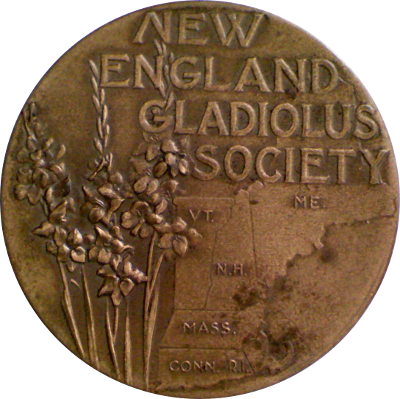
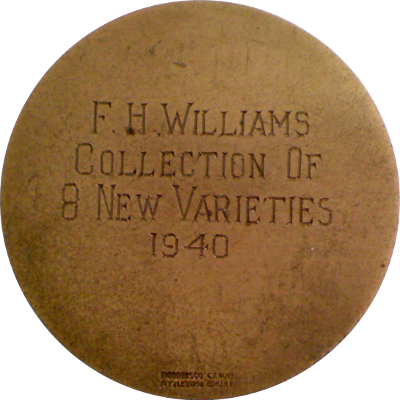
The obverse bears three iris stalks on left, a map of the New England states labeled VT, ME, N.H., MASS., CONN. and RI. on right. At top, NEW / ENGLAND / GLADIOLUS / SOCIETY
The reverse bears maker's mark ROBBINS CO. / ATTLEBORO - GENUINE / BRONZE. Inscription reading F. H. WILLIAMS / COLLECTION OF / NEW VARIETIES / 1940
The edge is unmarked.
The New England Gladiolus Society was created in 1920 when the Massachusetts Gladiolus Society changed its name to broaden its appeal to growers in all of New England. This date together with the dedication help us narrow down the medal's date, but not by much. Please contact me if you know the artist or the creation date.
The medal measures 51.3mm in diameter and was struck in bronze by the Robbins Company of Attleboro, Massachusetts.
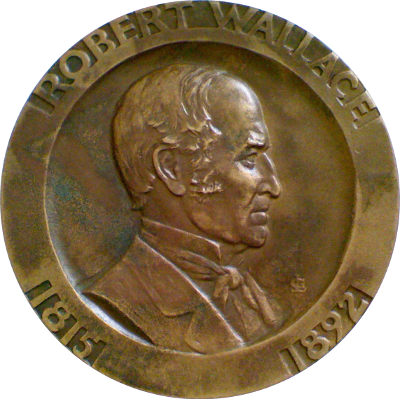
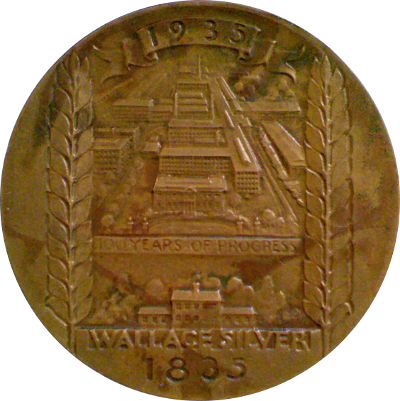
The obverse bears founder's bust left. Above, ROBERT WALLACE; below to left and right, 1815 - 1892; signed (GL monogram) in right field.
The reverse shows factory in upper center with single family house below. Above, 1935; across center, 100 YEARS OF PROGRESS; in exergue, WALLACE SILVER / 1835
The medal is edge-marked ROBBINS CO / ATTLEBORO - GENUINE / BRONZE.
The founder of Wallace Silversmiths, Robert Wallace was born in Prospect, Connecticut on November 13, 1815. He learned the silversmith trade and started a small business whose only product was spoons. One day, while shopping in New York City, Wallace happened upon a piece of cutlery made of a nickel alloy called German silver that had been produced by Dixon and Sons of Sheffield, England. Impressed by the quality and strength of the piece, Wallace bought the formula from the German chemist Dr. Louis Feuchtwanger who had a small bar of that metal from Germany for the then unheard sum of $20 and went on to build these new nickel silver spoons. Later he found a man who had brought the recipe for making the metal. Wallace purchased that too. In his factory, he then compounded the first German silver made in America and pioneered the new industry.
Wallace moved his company from Cheshire to Wallingford and increased production. Over the decades, the business grew tremendously and by 1935 it was mass-producing cutlery at an astonishing speed.
The medal measures 73mm (2 7/8in) and was struck in bronze by the Robbins Company of Attleboro, Massachusetts.
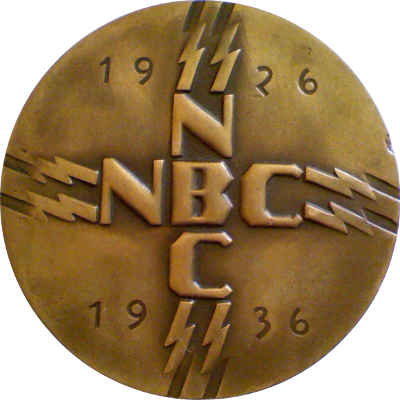
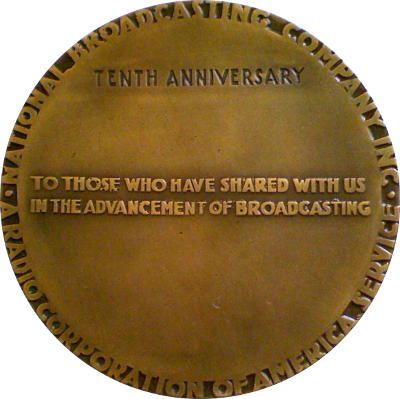
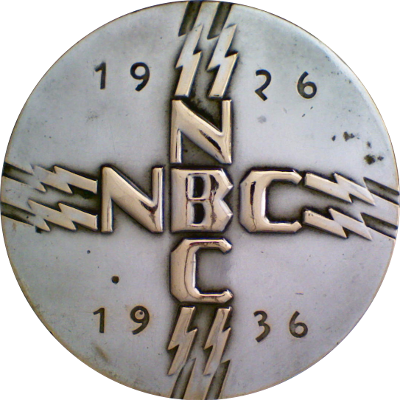
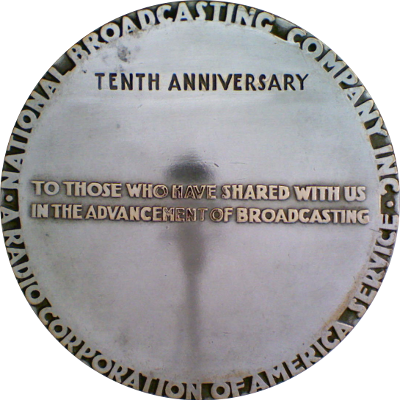
The obverse bears the old NBC logo crisscrossed in the center; double lightning bolts extending from all corners of the cross. On left and right of lightning bolts above, 19 / 26; on left and right of lighning bolts below, 19 / 36.
The reverse bears text only. Around, NATIONAL BROADCASTING COMPANY * A RADIO CORPORATION OF AMERICA SERVICE * ; in center field, TENTH ANNIVERSARY / TO THOSE WHO HAVE SHARED WITH US / IN THE ADVANCEMENT OF BROADCASTING.
The medal commemorates the tenth anniversary of the National Broadcasting Company which was founded in 1926. It was distributed to its employees in 1936. From Chris Bach, whom I owe big thanks for information about art medals, I learned the following:
This scarce Art Deco medal has long been "unsigned" in various auctions with no artist or sculptor identified or credited with the design. However, the Cleveland Museum of Art credits the medal as being a collaboration of three people: "modeled by Julio Kilenyi (American, b. 1885); obverse designed by Richard A Loederer (American, b. 1894) and the reverse designed by E.P.H. James (American)" - a gift to the museum's collection by the National Broadcasting Company in 1937 (No. 1937.9.A/B). A specimen at the New York Historical Society in NYC also credits Julio Kilenyi; and the Library of Congress collection identifies a similar item designed by Loederer in their NBC History Files: 1922-1986, Folder 173, Logos, "Photo of tenth anniversary (1936) plaque designed by Richard Loederer of Vienna."
This medal measures 76mm in diameter and was struck in bronze by the Robbins Company of Attleboro, Massachusetts.
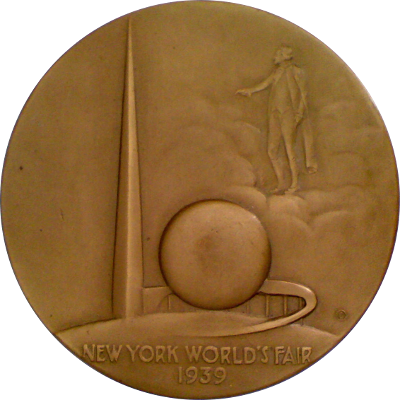
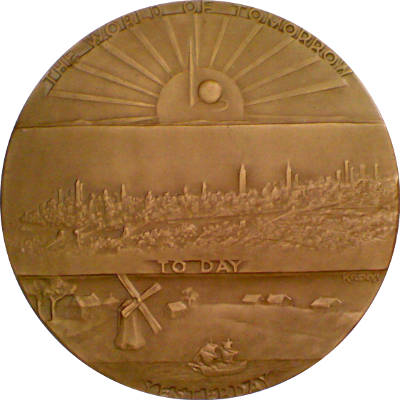
The obverse bears view of iconic Trylon and Perisphere; at upper right, a full length figure of George Washington emerges from cloud banks. At bottom, NEW YORK WORLD'S FAIR / 1939; at right, ©
The reverse bears three panels; top panel shows Trylon and Perisphere over radiant sun; above, THE WORLD OF TOMORROW; the middle panel shows view of Manhattan skyline as seen from the World's Fair grounds with legend TODAY; bottom panel shows view of New Amsterdam with legend YESTERDAY; signed at top right corner of bottom panel, KILENYI
The edge bears the marks ROBBINS CO. / ATTLEBORO - BRONZE.
This was the official medal of the New York World's Fair of 1939-40. The 190m-tall spire-shaped Trylon contained the (at the time) longest escalator and the 54m-diameter Perisphere housed a diorama called "Democracity" which depicted an topian city-of-the-future. A moving sidewalk transported spectators past the exhibits.
A much rarer version of the medal exists in which the year is 1940 rather than 1939.
The medal measures 63.5mm in diameter and was struck by the Robbins Company of Attleboro, Massachusetts.
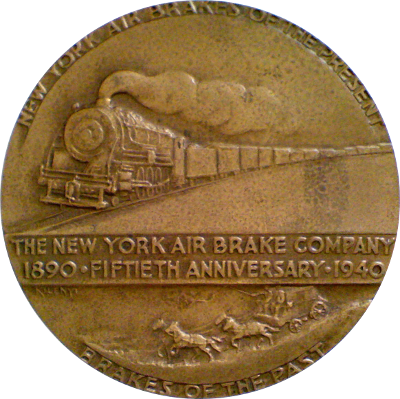
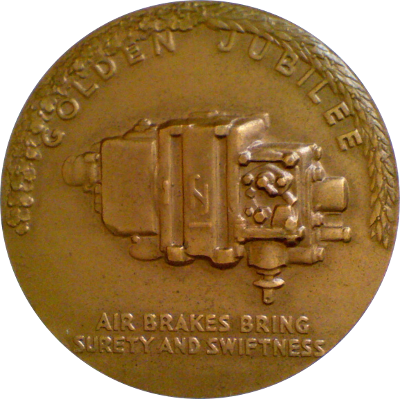
The obverse bears scene of steam train speeding around a bend in upper half. Two line inscription on a raised band across: THE NEW YORK AIR BRAKE COMPANY/ 1890 FIFTIETH ANNIVERSARY 1940. Underneath, a carriage drawn by 4 horses. Around top, NEW YORK AIR BREAKS OF THE PRESENT; below BRAKES OF THE PAST.
The reverse depicts an actual air brake. Above, under laurels, GOLDEN JUBILEE; below, AIR BRAKES BRING / SURETY AND SWIFTNESS
The medal is edge-marked ROBBINS CO / ATTLEBORO - GENUINE / BRONZE.
The New York Air Brake Company has a fascinating history including intrigue, corporate raiding, and even murder. In the late 19th century the booming railroad industry was in desperate need of a good braking system. As trains had gotten faster, slowing them down in a controlled fashion became an ever more pressing problem. By the 1860s, two systems were competing for dominance: a vacuum system and a pressurized air system.
Frederick Eames was an inventor who moved to Watertown, NY, in 1874 where he founded the Eames Vacuum Brake Company in 1876. After his top sales man had attempted to cheat him out of the company, he went to court and won back control in 1882. Unfortunately, he was fatally shot while retaking the factory in 1883.
The company was re-incorporated by John Thompson in 1890 as the New York Air Brake Company. Wall Street raiders used manufactured bad news to profiteer in the stock markets. Two investors stayed faithful and protected the young company. While Westinghouse had pioneered air brakes and consequently had a lead in the marketplace, the industry was reluctant to accept one monopoly supplier. Consequently, New York Air Brakes prospered with the growing railroad industry. Finally, in 1912, Westinghouse and New York Air Brakes agreed to share the market and started cooperating on research and development.
While the somewhat pedestrian motif of an air brake on the medal's reverse does not seem all too poetic, the fascinating story more than makes up for any perceived shortcomings. It is a beautiful example of an industrial medal of the 1940s.
The medal measures 76mm (3in) and was struck by the Robbins Company of Attleboro, Massachusetts in bronze.
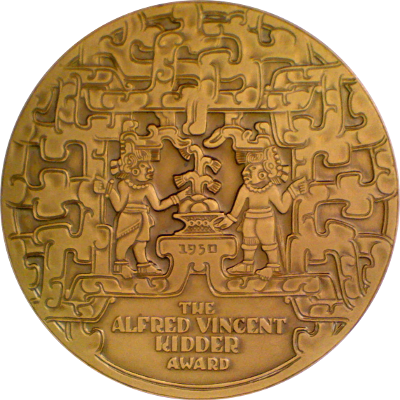
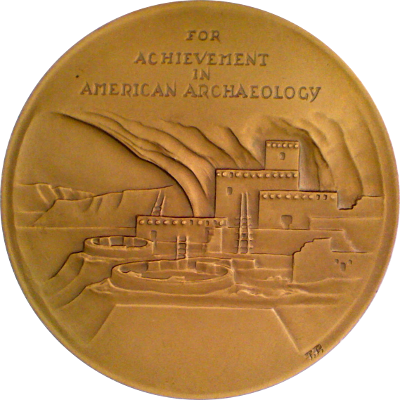
The medal's obverse bears a classic Mayan motif of two priests at an altar. Incuse on altar, 1950; In exergue, THE / ALFRED VINCENT / KIDDER / AWARD
The reverse shows a Southwestern pueblo under cliff or in cave, maybe Mesa Verde. Above, FOR / ACHIEVEMENT / IN / AMERICAN ARCHAEOLOGY; signed T.P. along rim in lower right.
The edge is marked at 12:00, ROBBINS CO. ATTLEBORO / GENUINE BRONZE
Alfred Vincent Kidder (October 29, 1885 � June 11, 1963) was an American archaeologist considered the foremost of the southwestern United States and Mesoamerica during the first half of the 20th century. He saw a disciplined system of archaeological techniques as a means to extend the principles of anthropology into the prehistoric past and so was the originator of the first comprehensive, systematic approach to North American archaeology.
Established in 1950, the Alfred Vincent Kidder Award for Eminence in the Field of American Archaeology was given every three years to an outstanding archaeologist specializing in the archaeology of the Americas. The award has been given alternately to specialists in Mesoamerican archaeology and the archaeology of the Southwestern region &emdash; areas that were both central to the pioneering and exemplary work of A. V. Kidder.
This award, presented by the AAA but selected by the Archaeology Division of AAA, is now given every two years.
The medal expresses the two different archeaological areas of interest through the imagery on the two sides, both of which were designed by Tatiana Proskouriakoff (1909-1985). She not only designed the medal but was also the award's fifth recipient. The Mayan motif on the obverse represents the Mesoamerican area, whereas the pueblo scene on the reverse represents the Northamerican Southwest.
The medal measures 76mm (3in) in diameter and was struck in bronze by the Robbins Company of Attleboro, Massachusetts.